
Brunsvigia is a genus of African flowering plants in the family Amaryllidaceae, subfamily Amaryllidoideae. It contains about 20 species native to southeastern and southern Africa from Tanzania to the Cape Provinces of South Africa.

Protea laurifolia, also known as the grey-leaf sugarbush, is a shrub from South Africa. It is native to the Cape Provinces of South Africa.
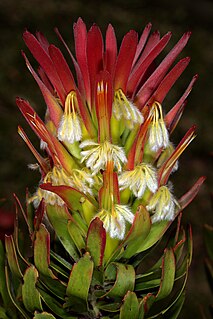
Mimetes, the pagoda, is a genus of evergreen shrubs or small trees 0.5–6 m (1.6–19.7 ft) high, with thirteen species assigned to the family Proteaceae. This genus, as with other proteas, is popular with nectarivorous birds such as the Cape sugarbird and several sunbird species. All species of Mimetes are endemic to the Cape Floristic Region of South Africa.
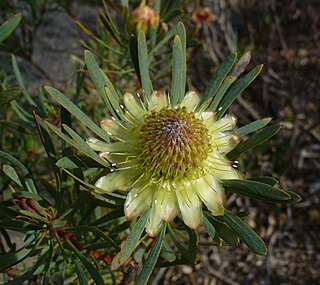
Protea scolymocephala, also known as the thistle protea or thistle sugarbush, is a flowering plant from the genus Protea native to South Africa.

Phaneroglossa is a genus of plants that is assigned to the daisy family. It consists of only one species, Phaneroglossa bolusii, a perennial plant of up to 40 cm high, that has leathery, line- to lance-shaped, seated leaves with mostly few shallow teeth and flower heads set individually on top of long stalks. The flower head has an involucre of just one whorl of bracts, few elliptic, white or cream ray florets, and many yellow disc florets. It is an endemic species of the Western Cape province of South Africa. Flowering mainly occurs from November to January.
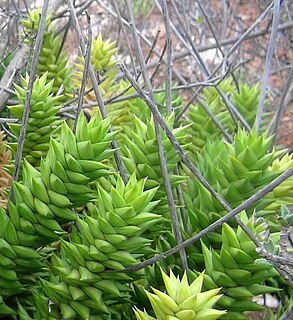
Astroloba spiralis is a small succulent plant of the Astroloba genus, endemic to the southern Karoo regions of the Western and Eastern Cape Provinces, South Africa.

Leucospermum pedunculatum is an evergreen, low shrub of 15–30 cm (5.9–11.8 in) high spreading from a single stern upright stem, from the family Proteaceae. The powdered or hairless line-shaped to somewhat sickle-shaped leaves are 3–6 cm (1.2–2.4 in) long and 2–5 mm (0.08–0.20 in) wide. The stalked, individually set flower heads are globe-shaped, 2½−3 cm in diameter consist of initially white to pale cream flowers that eventually turn carmine. From the center of the flowers emerge straight styles that jointly give the impression of a pincushion. It is called white-trailing pincushion in English. It flowers from August to January, peaking in September. It is an endemic species that is restricted to a narrow strip on the south coast of the Western Cape province of South Africa.

Protea pendula, also known as the nodding sugarbush or arid sugarbush, is a flowering plant of the genus Protea, in the family Proteaceae, which is only found growing in the wild in the Cape Region of South Africa. In the Afrikaans language it is known as knikkopsuikerbossie or ondersteboknopprotea.

Protea foliosa, also known as the leafy sugarbush, is a flowering plant of the genus Protea in the family Proteaceae which is endemic to the Cape Region of South Africa. In the Afrikaans language it is known as ruie-suikerbos.
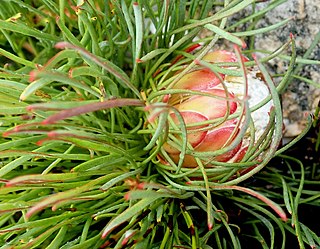
Protea montana also known as the Swartberg sugarbush, is a flowering plant of the genus Protea within the family Proteaceae, which is endemic to the southwestern Cape Region of South Africa. In Afrikaans it is known as swartbergsuikerbos.
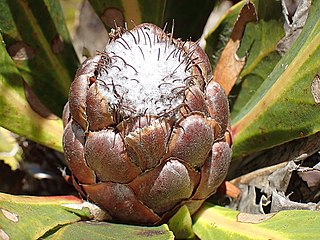
Protea vogtsiae, also known as the Kouga sugarbush, is a small flowering shrub of the genus Protea within the family Proteaceae, which is only found growing in the wild in the southern Cape Region of South Africa.

Protea burchellii, also known as Burchell's sugarbush, is a flowering shrub in the genus Protea, which is endemic to the southwestern Cape Region of South Africa.

Protea angustata, also known as the Kleinmond sugarbush, is a flowering shrub that belongs to the genus Protea. This plant is endemic to the south-west Cape Region of South Africa.
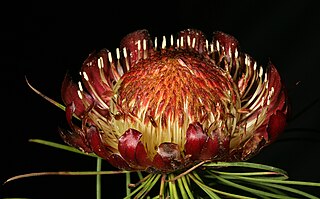
Protea pityphylla, also known as Ceres sugarbush or mountain rose, is a flowering shrub of the genus Protea, in the family Proteaceae. The plant is endemic to the southwestern Cape Region of South Africa.
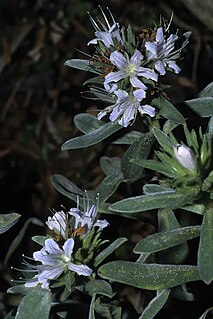
Lobostemon montanus, the turquoise bush bugloss, mountain lobostemon or agtdaegeneesbos, is a South African species belonging to the forget-me-not family.

Lobostemon capitatus is a species belonging to the forget-me-not family. It is endemic to the Western Cape of South Africa, where it is found between Porterville and Bredasdorp.
Lobostemon cinereus, the ash healthbush, is a species belonging to the forget-me-not family. It is endemic to South Africa.
Lobostemon daltonii, the Infanta healthbush, is a species of the forget-me-not family endemic to South Africa.
Lobostemon decorus, the Rooiberg healthbush, is a species belonging to the forget-me-not family. It is endemic to the Western Cape of South Africa.
Zyrphelis decumbens is a perrenial species of plant from the Bainskloof Mountains in South Africa.















